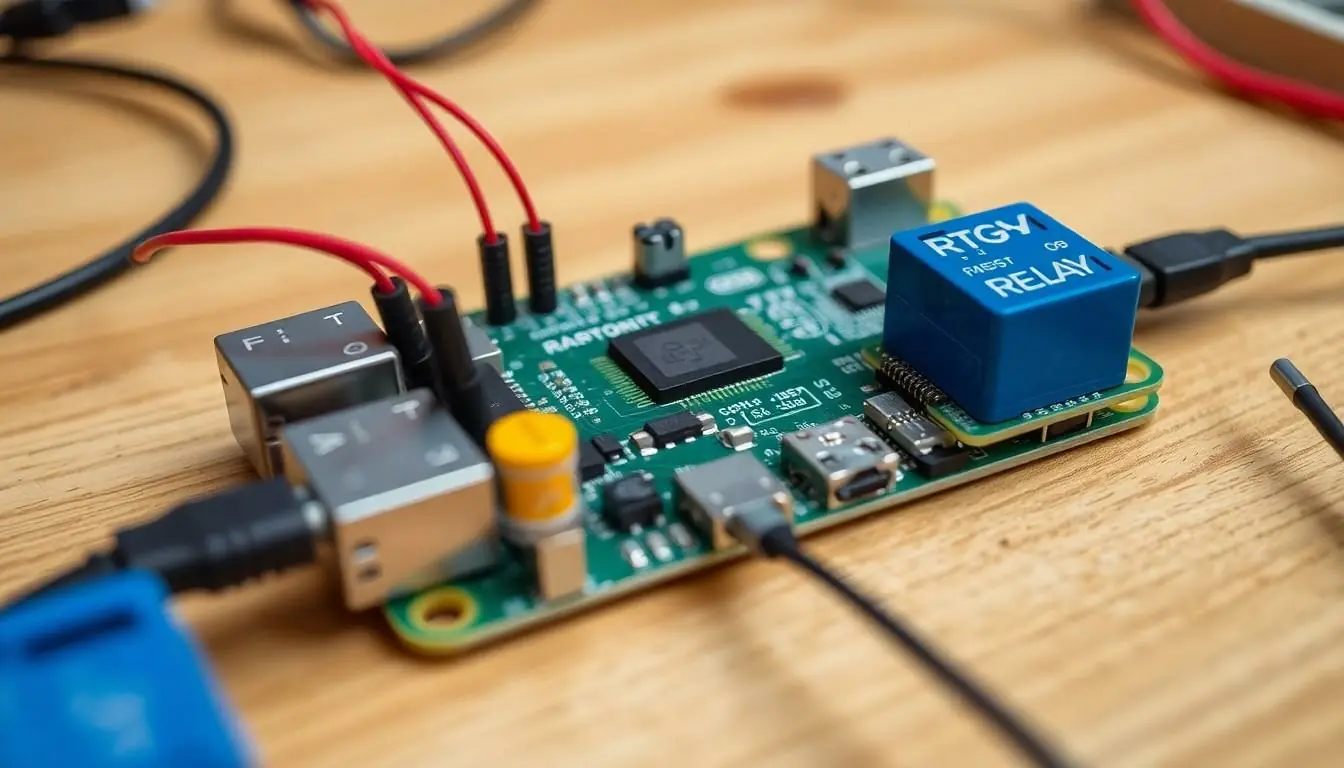Imagine turning your home into a tech-savvy haven without breaking the bank. With Raspberry Pi, the tiny computer that packs a punch, it’s easier than ever to automate everyday tasks and impress your friends. From controlling lights with a simple voice command to monitoring your garden’s moisture level, the possibilities are endless—and fun!
Table of Contents
ToggleOverview Of Raspberry Pi Home Automation Projects
Raspberry Pi serves as an ideal platform for various home automation projects due to its affordability and versatility. Users can set up smart lighting systems that adjust brightness based on the time of day. Homeowners benefit from enhancing their security by integrating cameras and motion sensors, all manageable through a single interface.
Implementing temperature and humidity control systems is straightforward with Raspberry Pi. This enables individuals to maintain a comfortable environment while saving energy consumption. Smart garden systems further utilize sensors to track soil moisture levels and automate watering schedules, making gardening more efficient.
Voice-controlled assistants offer significant integration possibilities. By using voice commands, individuals can control appliances, lights, and even heating systems, adding convenience to daily routines. Custom dashboards allow users to monitor and manage devices from their smartphones, ensuring seamless interaction.
Raspberry Pi supports various protocols, including MQTT and HTTP, which enhance communication between devices. Users often set up automation routines that trigger based on specific conditions, such as turning on lights at sunset. This adaptability leads to improved energy efficiency and increased comfort in living spaces.
Popular projects involve creating media centers, where Raspberry Pi transforms standard televisions into smart devices. Connecting streaming services and local media libraries makes the entertainment experience more enjoyable. Smart mirrors represent another trend, displaying time, weather forecasts, and notifications while blending seamlessly into home decor.
Overall, the range of Raspberry Pi home automation projects illustrates its utility. With continuous advancements in technology, opportunities for innovation within home ecosystems expand, encouraging creativity and enhancing the user experience.
Getting Started With Raspberry Pi

Raspberry Pi serves as an excellent platform for home automation projects. It’s affordable, versatile, and integrates seamlessly into various applications.
Choosing The Right Raspberry Pi Model
Models such as Raspberry Pi 4 or Raspberry Pi Zero W are popular choices. The Raspberry Pi 4 offers superior performance with its quad-core CPU and multiple USB ports. For simpler projects, the Raspberry Pi Zero W provides a compact solution with built-in Wi-Fi capabilities. Users must consider project requirements when selecting a model, as processing power and connectivity options play crucial roles.
Essential Components For Home Automation
Critical components include sensors, actuators, and a reliable power supply. Temperature sensors measure ambient conditions, while motion sensors provide security alerts. Relay modules control appliances, creating a link between software commands and physical devices. Raspberry Pi cameras offer visual monitoring, useful for security applications. Wireless communication modules like Wi-Fi and Zigbee enable integration with various smart devices. Each component enhances the functionality of home automation systems, amplifying the overall experience.
Popular Raspberry Pi Home Automation Projects
Raspberry Pi enables a variety of exciting home automation projects that enhance convenience and security. Below are some widely implemented projects.
Smart Lighting Solutions
Smart lighting solutions allow users to control their lights remotely. Programmable systems can adjust brightness according to the time of day. Users can integrate voice commands through assistants for hands-free operation. Detailed automation routines enable lights to turn on or off based on occupancy. These systems utilize inexpensive sensors, making them a cost-effective option for transforming any home.
Home Security Systems
Home security systems built with Raspberry Pi provide enhanced monitoring capabilities. Users can connect cameras and motion sensors to create a comprehensive surveillance setup. Automatic alerts notify users of unusual activity, ensuring peace of mind. By utilizing cloud services, recorded footage becomes accessible from anywhere, streamlining monitoring. Integrating door/window sensors increases security that adapts to individual needs for safeguarding homes.
Climate Control Projects
Climate control projects optimize indoor environments for comfort and energy efficiency. Systems can monitor temperature and humidity levels in real-time using sensors. Automated responses, such as adjusting thermostats, enhance energy conservation. Users can implement remote control through custom apps, adapting climate settings intuitively. Tailoring specific preferences for different rooms creates an enjoyable living atmosphere while reducing energy costs.
Programming And Automation Tools
Raspberry Pi offers powerful programming and automation tools for home projects. These tools simplify the creation and management of automated systems.
Using Python For Automation
Python stands out as the primary programming language for automation on Raspberry Pi. Its versatility and simplicity allow users to write scripts for various tasks. Libraries like RPi.GPIO enable control of hardware components such as sensors and relays. Furthermore, users can leverage Raspberry Pi’s extensive documentation and community support to troubleshoot and enhance projects. Automation tasks like turning on lights or monitoring temperature sensors become straightforward with Python’s libraries. This language empowers creators to build custom solutions with minimal coding experience.
Integrating With Smart Home Protocols
Integrating with smart home protocols enhances Raspberry Pi’s automation capabilities. Protocols such as MQTT, Zigbee, and Z-Wave enable seamless communication between devices. Using MQTT allows devices to send and receive messages efficiently over the network. On the other hand, Zigbee and Z-Wave offer low-power options for connecting multiple devices in the home. Home automation systems become more robust when integrating these protocols, providing users with centralized control over their smart devices. This integration not only improves functionality but also increases compatibility with other smart home ecosystems.
Troubleshooting Common Issues
Raspberry Pi users may encounter several common issues while setting up home automation projects. No internet connection can hinder functionality. Check the Wi-Fi settings or Ethernet connection to ensure the device is connected. Sometimes, rebooting the router can also resolve connectivity problems.
Power supply issues might cause shutdowns or performance drops. Ensuring the power supply meets the Raspberry Pi’s requirements, typically 5V 2.5A for models like the Raspberry Pi 3 and 4, helps maintain stability. Using a quality power supply is essential to prevent fluctuations.
Software compatibility issues often arise with different automation tools or libraries. Verifying the installation of the necessary libraries or updating to the latest version can resolve this. Different systems may also require specific configuration settings, so checking the documentation or online forums can provide solutions.
Sensor malfunctions can disrupt automation tasks. Ensuring proper wiring and compatible sensors with the Raspberry Pi is crucial. Additionally, testing sensors separately can help determine if they are functioning correctly or require replacement.
Remote access problems may prevent users from controlling home automation systems off-site. Port forwarding on the router and using dynamic DNS services can enhance remote connectivity. Firewall settings should also be reviewed, as they may inadvertently block access.
Overall, these troubleshooting steps help users address common challenges in Raspberry Pi home automation projects. Identifying and resolving issues promptly ensures a smoother experience and reliable operation for home automation tasks.
Raspberry Pi opens up a world of possibilities for home automation that are both accessible and enjoyable. With its affordability and versatility users can easily create systems that enhance their living spaces. From smart lighting to advanced security solutions each project not only improves convenience but also encourages creativity.
The integration of various sensors and communication protocols allows for seamless automation tailored to individual needs. This technology empowers users to take control of their environments while optimizing energy efficiency and comfort. Embracing Raspberry Pi for home automation is a step towards a smarter and more connected home experience.





